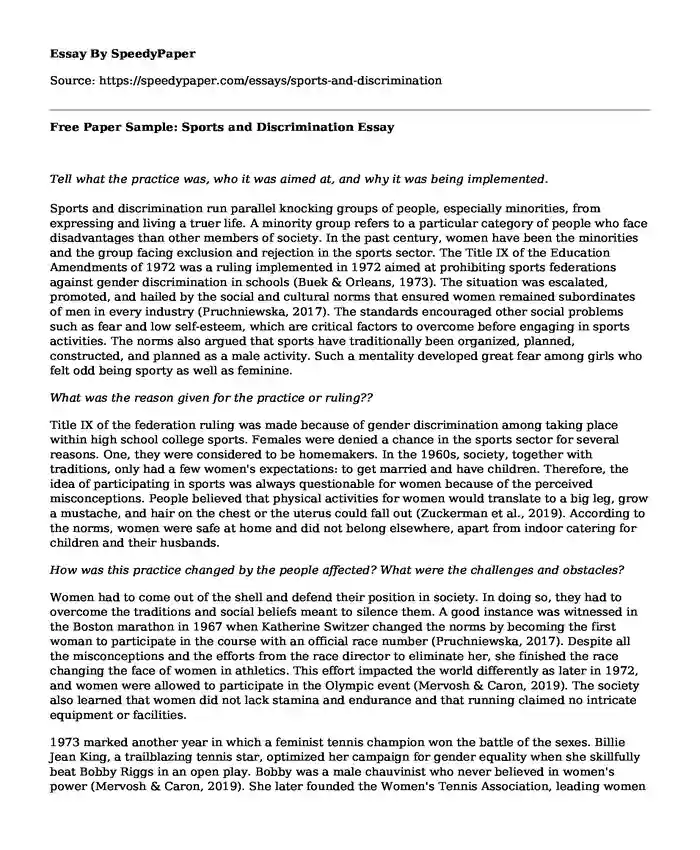
| Essay type: | Evaluation essays |
| Categories: | Women Discrimination Sport Social issue |
| Pages: | 3 |
| Wordcount: | 816 words |
Tell what the practice was, who it was aimed at, and why it was being implemented.
Sports and discrimination run parallel knocking groups of people, especially minorities, from expressing and living a truer life. A minority group refers to a particular category of people who face disadvantages than other members of society. In the past century, women have been the minorities and the group facing exclusion and rejection in the sports sector. The Title IX of the Education Amendments of 1972 was a ruling implemented in 1972 aimed at prohibiting sports federations against gender discrimination in schools (Buek & Orleans, 1973). The situation was escalated, promoted, and hailed by the social and cultural norms that ensured women remained subordinates of men in every industry (Pruchniewska, 2017). The standards encouraged other social problems such as fear and low self-esteem, which are critical factors to overcome before engaging in sports activities. The norms also argued that sports have traditionally been organized, planned, constructed, and planned as a male activity. Such a mentality developed great fear among girls who felt odd being sporty as well as feminine.
What was the reason given for the practice or ruling??
Title IX of the federation ruling was made because of gender discrimination among taking place within high school college sports. Females were denied a chance in the sports sector for several reasons. One, they were considered to be homemakers. In the 1960s, society, together with traditions, only had a few women's expectations: to get married and have children. Therefore, the idea of participating in sports was always questionable for women because of the perceived misconceptions. People believed that physical activities for women would translate to a big leg, grow a mustache, and hair on the chest or the uterus could fall out (Zuckerman et al., 2019). According to the norms, women were safe at home and did not belong elsewhere, apart from indoor catering for children and their husbands.
How was this practice changed by the people affected? What were the challenges and obstacles?
Women had to come out of the shell and defend their position in society. In doing so, they had to overcome the traditions and social beliefs meant to silence them. A good instance was witnessed in the Boston marathon in 1967 when Katherine Switzer changed the norms by becoming the first woman to participate in the course with an official race number (Pruchniewska, 2017). Despite all the misconceptions and the efforts from the race director to eliminate her, she finished the race changing the face of women in athletics. This effort impacted the world differently as later in 1972, and women were allowed to participate in the Olympic event (Mervosh & Caron, 2019). The society also learned that women did not lack stamina and endurance and that running claimed no intricate equipment or facilities.
1973 marked another year in which a feminist tennis champion won the battle of the sexes. Billie Jean King, a trailblazing tennis star, optimized her campaign for gender equality when she skillfully beat Bobby Riggs in an open play. Bobby was a male chauvinist who never believed in women's power (Mervosh & Caron, 2019). She later founded the Women's Tennis Association, leading women female players to various tournaments. Her fight for women and gay people's rights made her the most outstanding athlete of the 20th century.
Recently, the United States soccer players downed their tools and filed a gender discrimination lawsuit against the soccer federation. They argued that they play more games than the men's team and win more of them, but women receive less pay. Such discrimination not only affected their paychecks but also when and how often they played. They also received inadequate medical care and coaching with poor means of transport (Mervosh & Caron, 2019). Their prominence and willingness to fight paid dividends as the federation doubled their prize money and improved the general sports conditions for future matches.
What is the status today?
Generally, the modern world has changed significantly due to these brilliant women's efforts in history. Gender equality has become one of the critical factors highly observed across all sports activities. Such memoirs also equip the young generation with enormous power to defend themselves and their position in society. Such strength enables them to speak up through organizations and women's groups in which they fight for other minorities' rights in our cruel world.
References
Mervosh, S., & Caron, C. (2019, March 8). 8 Times Women in Sports Fought for Equality. The New York Times. https://www.nytimes.com/2019/03/08/sports/women-sports-equality.html
Pruchniewska, U. M. (2017). "A Crash Course in Herstory": Remembering the Women's Movement inMAKERS: Women Who Make America. Southern Communication Journal, 82(4), 228–238. https://doi.org/10.1080/1041794x.2017.1332089
Zuckerman, G., Zuckerman, G., & Zuckerman, E. (2019). Rising above: inspiring women in sports. Puffin Books.
Buek, A. P., & Orleans, J. H. (1973). Sex discrimination--a bar to democratic education: Overview of Title IX of the education amendments of 1972. Conn. L. Rev., 6, 1.
Cite this page
Free Paper Sample: Sports and Discrimination. (2023, Oct 09). Retrieved from https://speedypaper.com/essays/sports-and-discrimination
Request Removal
If you are the original author of this essay and no longer wish to have it published on the SpeedyPaper website, please click below to request its removal:
- Free Essay on Race and Racism: Holy Wars and Islamophobia in the Past and Present
- Changes in Race Relation After the Civil War - Free Paper Example
- Free Essay: Truancy, Grade Point Average and Sexual Activity
- Paper Example on Festivals Tourism and Event Management
- Free Paper on Dr. Lim's Academic Articles
- Essay Example on Ensuring Workplace Safety: The Role of Performance Management
- Essay Example. The Structure of a Deductive Argument
Popular categories




